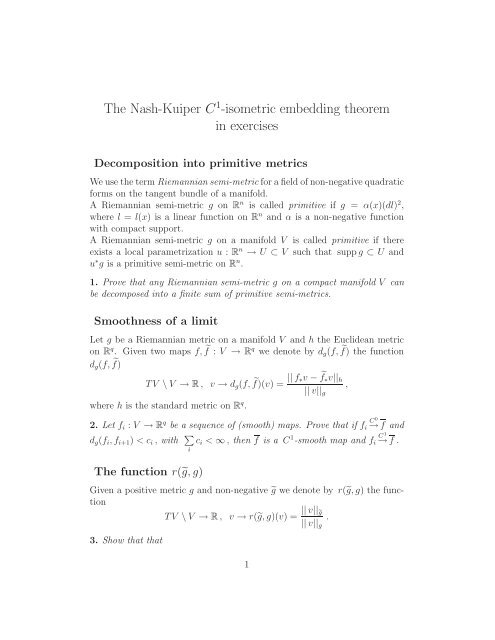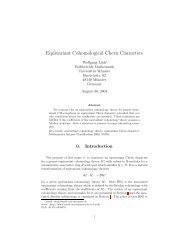The Nash-Kuiper C -isometric embedding theorem in exercises
The Nash-Kuiper C -isometric embedding theorem in exercises
The Nash-Kuiper C -isometric embedding theorem in exercises
You also want an ePaper? Increase the reach of your titles
YUMPU automatically turns print PDFs into web optimized ePapers that Google loves.
<strong>The</strong> <strong>Nash</strong>-<strong>Kuiper</strong> C 1 -<strong>isometric</strong> <strong>embedd<strong>in</strong>g</strong> <strong>theorem</strong><strong>in</strong> <strong>exercises</strong>Decomposition <strong>in</strong>to primitive metricsWe use the term Riemannian semi-metric for a field of non-negative quadraticforms on the tangent bundle of a manifold.A Riemannian semi-metric g on R n is called primitive if g = α(x)(dl) 2 ,where l = l(x) is a l<strong>in</strong>ear function on R n and α is a non-negative functionwith compact support.A Riemannian semi-metric g on a manifold V is called primitive if thereexists a local parametrization u : R n → U ⊂ V such that supp g ⊂ U andu ∗ g is a primitive semi-metric on R n .1. Prove that any Riemannian semi-metric g on a compact manifold V canbe decomposed <strong>in</strong>to a f<strong>in</strong>ite sum of primitive semi-metrics.Smoothness of a limitLet g be a Riemannian metric on a manifold V and h the Euclidean metricon R q . Given two maps f, ˜f : V → R q we denote by d g (f, ˜f) the functiond g (f, ˜f)TV \ V → R , v → d g (f, ˜f)(v) = || f ∗v − ˜f ∗ v|| h|| v|| g,where h is the standard metric on R q .2. Let f i : V → R q Cbe a sequence of (smooth) maps. Prove that if f 0i →f andd g (f i , f i+1 ) < c i , with ∑ c i < ∞ , then f is a C 1 C-smooth map and f i →f 1.i<strong>The</strong> function r(˜g, g)Given a positive metric g and non-negative ˜g we denote by r(˜g, g) the functionTV \ V → R , v → r(˜g, g)(v) = || v|| eg|| v|| g.3. Show that that1
(r1) r(˜g, g 1 ) ≤ r(˜g, g 2 ) if g 1 ≥ g 2and(r2) r(˜g, g) ≤ r(˜g + g 1 , g + g 1 ) if r(˜g, g) ≤ 1 .One-dimensional approximationAn <strong>embedd<strong>in</strong>g</strong> (V, g) → (R q , h) is called short (resp. strictly short) if theform g − f ∗ h ≤ h is non-negative, i.e. semi-metric (resp. positive def<strong>in</strong>ite).4. Let g be any Riemannian metric on the <strong>in</strong>terval I. Prove that if q > 1then for any ε > 0 any short <strong>embedd<strong>in</strong>g</strong> f : (I, g) → (R q , h) can be C 0 -approximated by ε-<strong>isometric</strong> <strong>embedd<strong>in</strong>g</strong>s. Moreover, for any ρ > 0 the approximat<strong>in</strong>gmap ˜f can be chosen <strong>in</strong> such a way thatwhere ∆ = g − f ∗ h.Add<strong>in</strong>g a primitive metricd g (f, ˜f) < r(∆, g) + ρProve the follow<strong>in</strong>g generalization of Exercise 4:5. Suppose that dim V = n < q. Let f : (V, g) → (R q , h) be a short <strong>embedd<strong>in</strong>g</strong>such that ∆ = g − f ∗ h is a primitive semi-metric on V . <strong>The</strong>n for any ε the<strong>embedd<strong>in</strong>g</strong> f can be C 0 -approximated by ε-<strong>isometric</strong> <strong>embedd<strong>in</strong>g</strong>s. Moreover,for any ρ > 0 the approximat<strong>in</strong>g map ˜f can be chosen to satisfy the <strong>in</strong>equalityApproximation <strong>The</strong>oremd g (f, ˜f) < r(∆, g) + ρ .An <strong>embedd<strong>in</strong>g</strong> f : (V, g) → (R q , h) is called ε-<strong>isometric</strong> if(1 − ε)g < f ∗ h < (1 + ε)g .Prove the follow<strong>in</strong>g Approximation <strong>theorem</strong>:6. Let n < q. For any ε > 0, any short <strong>embedd<strong>in</strong>g</strong> f : (V n , g) → (R q , h)can be C 0 -approximated by ε-<strong>isometric</strong> <strong>embedd<strong>in</strong>g</strong>s. Moreover, given a fixeddecomposition of a Riemannian semi-metric∆ = g − f ∗ h2
<strong>in</strong>to a sum of N primitive metrics then for any constant ρ > 0 one can choosean approximat<strong>in</strong>g <strong>embedd<strong>in</strong>g</strong> ˜f which satisfies the <strong>in</strong>equalityd g (f, ˜f) < N r(∆, g) + ρ .<strong>Nash</strong>-<strong>Kuiper</strong>’s C 1 -<strong>isometric</strong> <strong>embedd<strong>in</strong>g</strong> <strong>theorem</strong>Deduce from Exercises 6 and 2 the <strong>Nash</strong>-<strong>Kuiper</strong> C 1 -<strong>isometric</strong> <strong>embedd<strong>in</strong>g</strong><strong>theorem</strong>:7. If n < q then any strictly short immersionf : (V n , g) → (R q , h) ,where h is the standard metric on R q , can be C 0 -approximated by <strong>isometric</strong>C 1 -smooth immersions. Moreover, if the <strong>in</strong>itial immersion f is an <strong>embedd<strong>in</strong>g</strong>then f can be approximated by <strong>isometric</strong> C 1 -<strong>embedd<strong>in</strong>g</strong>s.Bound for the regularity <strong>in</strong> the <strong>Nash</strong>-<strong>Kuiper</strong> <strong>theorem</strong>8. Show that the h-pr<strong>in</strong>ciple type results fail for C 2 -<strong>isometric</strong> immersions.3
















